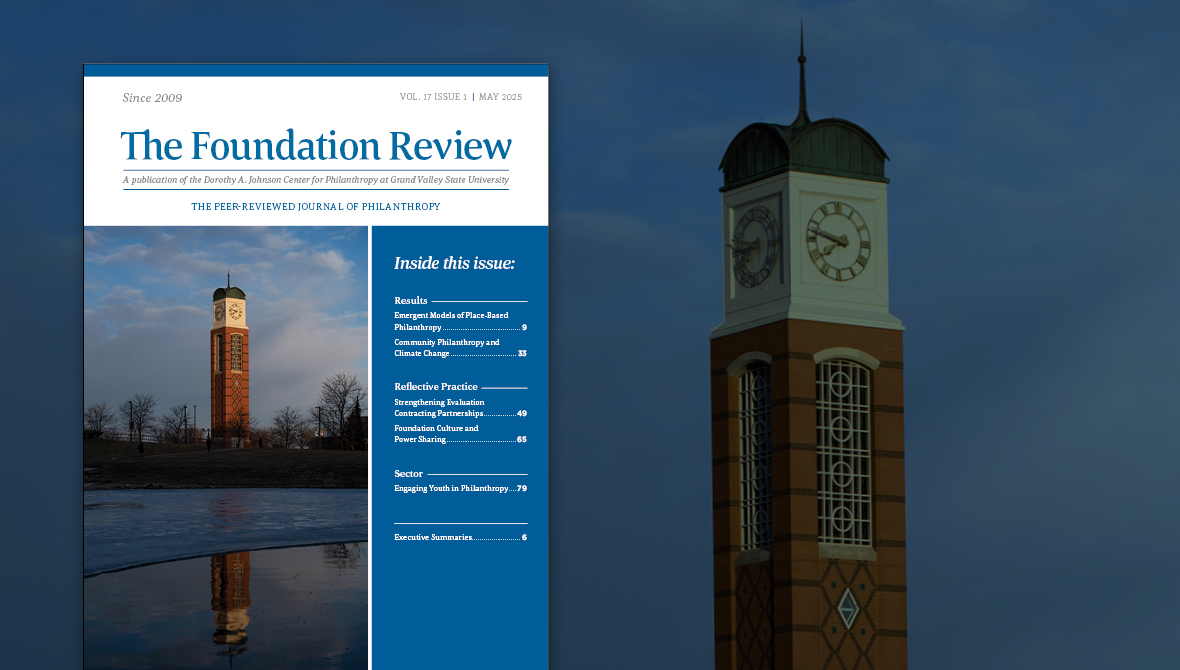Inside The Foundation Review, Volume 17, Issue 1



While this issue was not initially developed to address a common theme, the five articles in it each tell us something about a concept that is top-of-mind as this issue goes to press — our ability to be resilient in the face of significant challenges or change. Resilience is our ability as individuals, organizations, or communities to adapt, recover, and thrive despite substantial disruptions. Disruptions have many forms, and they can be experienced as either challenges or as opportunities for new thinking. Their causes may be economic (recessions or periods of significant growth, for example), natural (disasters), political (transfers of power), social (changing norms), technological (artificial intelligence), or even organizational (leadership changes).
Each article offers unique insights into how foundations can support resilience through their own philanthropic practices or their external grantmaking. Two articles focus on how to increase the flexibility, preparedness, and resilience of philanthropic strategies in local communities or geographic places. Two others focus on learning and evaluation as critical to short- and long-term adaptability and resilience. And one article raises the importance of youth in shoring up and sustaining both present and future resilience.
Change is constant. As foundations grapple with how to ensure their grantmaking and grantees can anticipate change and adapt to it, these articles offer ideas and lessons about how to meet the challenge.


Julia Coffman
Editor-in-Chief
The Foundation Review
Traditional approaches to place-based philanthropy, including comprehensive community initiatives, have had only limited success over 30 years of foundation practice. In response, a growing number of foundations have been experimenting with a more emergent place-based model. In this approach, the projects pursued by local actors evolve over the course of the initiative. Foundation staff cultivate this work and are deeply engaged with a wide range of local actors rather than focusing on a single planning entity. This article summarizes evaluation data from six foundations that have worked in this way: The California Endowment, the Clinton Foundation, Kate B. Reynolds Charitable Trust, The Ford Family Foundation, The Colorado Trust, and The Colorado Health Foundation. The available evaluations indicate that the six initiatives have each stimulated a broad range of local actors to step out into new work. The results are discussed with regard to both the extra value that foundations add by operating in a cultivating mode and the question of how much communitywide impact they can achieve with even the highest functioning place-based initiative.
Although the role of community foundations and United Way agencies is sometimes overlooked, an Indiana statewide study confirms that most directly contribute to meeting local disaster response needs. The study also showed that although half of all community foundations and United Ways report past service disruptions due to the more severe weather caused by climate change, the majority have not discussed the need to plan for disasters with their boards of directors to assure business continuity. In addition, community foundations lag behind United Ways and direct service nonprofits in risk mitigation, and their leaders are more likely to downplay the potential impacts of climate change on state residents. The article offers recommendations for how climate change discussions can be depoliticized by focusing on each community’s lived experiences with disaster, conducting risk assessments, and networking to share information and effective practices.
Foundations often support initiatives in multiple countries and cultures with limited access to the people and local contexts in which activities occur. To gain a deep and nuanced understanding of their investments’ relevance, effectiveness, and sustainability, foundations are often eager to partner with evaluators close to the contexts and people who participate in and are most affected by their investments. Yet, foundations’ procurement and contracting systems may not be built for these partnerships. Through the Strengthening Evaluation Contracting Partnerships Initiative, the authors are addressing this challenge by helping foundations, small and proximate evaluation firms and evaluators, ally evaluation firms, and other medium and large-sized evaluation firms work together to identify practical actions each can take. The authors share highlights from their open letter to funders and learning since then, offer practical examples, and suggest a way forward. In the appendix, they offer a checklist that funders and other evaluation commissioners can use to strengthen their partnerships with small and proximate evaluation firms and evaluators.
Talk about shifting organization culture in philanthropies to share power and decision-making abounds. Examples of how foundation learning endeavors to disrupt culture in service of systems change, racial equity, and responsiveness are less common. This article provides a window into this demanding work at The California Wellness Foundation, and how internal collaboration and learning on the way to racial equity and power-sharing with communities unfolded. The authors introduce Learning Labs, an action research model that framed and scaffolded the investigation of philanthropic terms and practices. This catalyzed collaborative decision-making within cross-functional teams, while senior leaders acted as advisors. Treated as an innovation, the authors examine how Learning Labs were disruptive, how different players responded, and what conditions and supports made progress possible. They offer reflections on the role of learning, and on internal collaboration and decision-making that can lead to foundations sharing power with the communities they serve.
Traditional philanthropy has largely been top-down, with communities — including youth — having limited decision-making power. Despite philanthropy’s recent shift toward participatory approaches — in which foundations address systemic inequities by engaging the communities they serve in their initiatives —the young people in these historically excluded communities are often ignored as contributors to philanthropic strategy. In this article, the author advances a theoretical framework, Youth-Possible Philanthropy.™ YPP deepens youth engagement by emphasizing possibility development, systems-level change, and equity-centered leadership. This article provides strategies for operationalizing YPP drawn from qualitative case study research with foundation leaders and staff; these include trust-building, multi-stakeholder convenings, and youth-defined metrics. Case examples illustrate how YPP can foster authentic power-sharing and bridge gaps in philanthropic practice, creating pathways for youth to drive long-term, sustainable impact in communities.